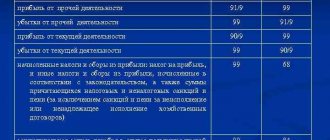How the financial result is reflected - postings
A loss in accounting (hereinafter referred to as BU) is determined at the end of the reporting period by comparing the costs incurred and the revenue received. The financial result (profit or loss) is obtained from the sum of the results for the usual types of activity for the enterprise and other inflows and outflows. To record financial results, the chart of accounts (approved by order of the Ministry of Finance of the Russian Federation dated October 31, 2000 No. 94n) provides for account 99 “Profit and Loss”. During the financial year, the periods for which interim reporting is generated are closed, and the following entries are made:
| Dt | CT | Description |
| 90.9 | 99 | Profit from ordinary activities is shown (if the turnover according to Kt 90.1 is greater than the sum of turnover according to Dt 90.2, 90.3, etc.) |
| 99 | 90.9 | The loss for ordinary activities is shown (if the turnover according to Kt 90.1 is less than the sum of the turnover according to Dt 90.2, 90.3, etc.) |
| 91.9 | 99 | The profit for other activities is shown (if the turnover according to Kt 91.1 is greater than the turnover according to Dt 91.2) |
| 99 | 91.9 | The loss for other activities is shown (if the turnover according to Kt 91.1 is less than the turnover according to Dt 91.2) |
Note that the reflection of the facts of financial and economic activities for all subaccounts of accounts 90 and 91 is carried out continuously throughout the year, on an accrual basis. And only when the balance sheet is reformed at the end of the year, they are reset by postings Dt 90.1 Kt 90.9, Dt 90.9 Kt 90.2 (90.3). For count 91, the reformation is performed in a similar way. Accordingly, the accountant does nothing with the loss incurred at the end of interim reporting periods - the financial results are simply accumulated in account 99. But at the end of the year, the accumulated balance in account 99 is included in retained earnings or uncovered losses by postings:
| Dt | CT | Description |
| 84 | 99 | The uncovered loss of the reporting year is shown |
| 99 | 84 | The profit of the reporting year is shown as part of retained earnings |
Reflection of loss according to PBU 18/02
In accordance with clause 1 of PBU 18/02, this Regulation provides for the reflection in accounting not only of the amount of income tax payable to the budget, or the amount of overpaid and (or) collected tax due to the organization, or the amount of the tax offset in the reporting period, but also the reflection in accounting of amounts that could affect the amount of income tax for subsequent reporting periods in accordance with the legislation of the Russian Federation.
The amount of income tax payable in PBU is called current tax. Let us clarify the meaning of this indicator. According to paragraph 22 of PBU 18/02, the current income tax (current tax loss) for each reporting period must be recognized in the financial statements as a liability equal to the amount of the unpaid tax
. Let us immediately note that the current tax loss and the current income tax are the same indicator.
Thus, the current income tax (IT) corresponds to the balance in the budget account (account 68). Calculations with the budget are a one-way street, therefore the negative value of the current tax (corresponding to the refund from the budget) cannot exceed the amount of advance contributions (overpayments) for the tax. In the absence of advance contributions, the current tax indicator cannot be negative
(TN>=0)
.
Let's call this statement the TN constraint. On the other hand, in accordance with paragraph 21 of PBU 18/02, current income tax is recognized as income tax for tax purposes, determined based on the amount of conditional expense (conditional income), adjusted to the amount of permanent tax liability, deferred tax asset and deferred tax liability of the reporting period. In the absence of permanent differences, deductible temporary differences and taxable temporary differences that give rise to permanent tax liabilities, deferred tax assets and deferred tax liabilities, the contingent income tax expense (notional income) will be equal to the current income tax (current tax loss ).
Clause 21 of PBU 18/02 provides an “adjustment scheme” for the conditional expense (CR) or conditional income (UD) for income tax. Taking into account the notations (abbreviations) introduced above, this scheme is written as a formula:
Current tax (TN) = UR(-UD)+PNO+ONA-ONO
; (1)
This formula is incomplete. In general, ONA and ONO have a balance at the beginning of the period (year) and a final balance; they can arise and be repaid. In the above formula for calculating the amount of current income tax, only changes in tax assets and liabilities for the period should be taken into account. In addition, the organization could transfer advance payments (AV) during the tax period. Taking into account advance payments and in accordance with clauses 17 and 18 of PBU 18/02, the “adjustment scheme” should look like:
-here the sign D indicates the change in the corresponding indicator for the period.
D(SHE)= emerging SHE – redeemable SHE,
D(IT) = arising IT - redeemed IT.
Let us note the different meanings of the indicators of formula (2). TN and AB are indicators of settlements with the budget, and UR(UD), PNO, ONA and ONO are intra-system financial indicators of the organization.
Suppose that at the end of the reporting period the organization has an accounting loss (conditional income). No advance payments were made. In this case, the “correction scheme” takes the form:
Expression (3) makes sense only when
This inequality expresses in another form the TN limitation formulated above.
Let us assume that the company has equal accounting and tax losses at the end of the tax period. In this case, PNO, ONA and ONO = 0, the current tax is also zero and is not equal to conditional income. Equalities (2) and (3) and inequality (4) are not satisfied.
However, in the subsequent tax period, an enterprise can use the tax loss partially or entirely in the manner prescribed by Article 283 of the Tax Code to reduce taxable profit, which indicates the presence of some deferred tax asset. This deemed tax asset is different from the deferred tax assets that arise when deductible temporary differences arise. In this case, there are no deductible temporary differences (at the end of the period the accounting loss is equal to the tax loss). Therefore, if you strictly follow the provisions of PBU 18/02, then the corresponding tax asset cannot arise. However, it is necessary to pay attention to the fact that after the balance sheet reformation at the beginning of the next tax period, the accounting loss is “zeroed” and the tax loss is carried forward, i.e. the reformation actually results in a difference at the beginning of the period. This difference can be repaid in the future, which allows us to make a statement about the need to reflect in the reporting before the reformation a deferred tax asset associated with
the amount of the tax loss
.
In order to distinguish deferred tax assets associated with tax loss carryforwards from “ordinary” ones, in the future we will call them compensating tax assets (CTA).
. The occurrence of such an asset should be reflected in the usual entry D 09 - K 68 in an amount determined as the product of the transferred tax loss and the income tax rate. In the analyzed situation, at the end of the reporting period, conditional income is reflected by posting D 68 - K 99 and a deferred tax asset corresponding to the transferred tax loss: D 09 - K 68. If the accounting and tax losses are equal, we have
TN = KNA – UD = 0
; (5)
Thus, KNA provide automatic execution of all the above expressions. In our opinion, KNA must be reflected in reporting not only at the end of the tax period, but also at the end of the reporting period.
Accounting loss and tax loss - postings
When, according to accounting and tax accounting data (hereinafter - NU), a profit is obtained and both values are equal, then there are no difficulties in calculating and reflecting income tax (hereinafter - IR) in accounting. If in one of the accounting systems - BU or NU - one financial result was obtained, and in the other - another, then when closing the period, attention should be paid to PBU 18/02, approved by order of the Ministry of Finance of Russia dated November 19, 2002 No. 114n. In our article we will look at cases where discrepancies in losses arise in accounting and accounting records.
ConsultantPlus experts explained how to apply PBU 18/02 when receiving a loss in accounting and tax accounting:
Get trial access to the K+ system and upgrade to the Ready Solution for free.
Read about the obligation to apply PBU 18/02 in the article “PBU 18/02 - who should apply and who should not?” .
According to Art. 283 of the Tax Code of the Russian Federation, an organization has the right to transfer losses received in the current tax period to the future, that is, to reduce the tax base by the amount of these losses in subsequent periods in full or in parts.
Read more about tax loss here.
Therefore, even if in the current period the financial results according to accounting and accounting standards are equal, then in subsequent periods, other things being equal, accounting and tax profits will differ, thus, a deductible temporary difference will arise (clause 11 of PBU 18/02). Please note that the loss carry forward rule only works for the tax period (year); it does not apply to losses for the reporting period.
Let's consider 3 cases of losses and related transactions.
The same loss in accounting and financial accounting
According to clause 20 of PBU 18/02, after the accountant determines the financial result according to the accounting data, he must calculate and reflect in accounting the conditional income or expense for the NP. This must be done because the tax loss for the reporting period is reset to zero (clause 8 of Article 274 of the Tax Code of the Russian Federation), and the financial result according to the accounting system remains unchanged. The amount is calculated by multiplying the accounting loss by the IR rate and is reflected by posting:
- Dt 68 Kt 99 - for the amount of conditional income for income tax.
Further, in case of a loss, a deferred tax asset (DTA) for the same amount should be reflected:
- Dt 09 Kt 68 - SHE.
Thus, if a loss is recorded in NU and ACC, then account 68, subaccount “NP” will have a zero balance, and the declaration for payment will also reflect 0. In this case, the resulting difference between 0 in NU and the amount of loss in ACC should be reflected in accounting (form SHE).
Loss in NU, profit in accounting
If a loss was formed in the NU, and a profit in the accounting book, then in the NU the expenses were greater or the income was less, which means that in the current period deferred tax liabilities (DTL) should be reflected for taxable temporary differences or permanent tax income (PTI) for permanent differences . When closing the period, the accountant reflects the conditional expense for the IR, which is compensated by previously made entries for IT or PND, thereby bringing the current IR to 0.
Let's look at this situation with an example.
Example
In Kaleidoscope LLC, the profit according to the accounting book is equal to 250 thousand rubles, the loss according to the accounting book is 500 thousand rubles. The difference arose due to the write-off by Kaleidoscope of the depreciation premium on the new fixed asset - 350 thousand rubles. (IT). Also, Kaleidoscope LLC received equipment free of charge from the founder - an individual who has a share in the authorized capital equal to 70%. The cost of the equipment was 400 thousand rubles. In the accounting system, this income is reflected as other income; in the tax accounting system, it is not recognized as taxable income (subclause 11, clause 1, article 251 of the Tax Code of the Russian Federation). The following entries were made in the accounting of Kaleidoscope LLC:
| Dt | CT | Amount, thousand rubles | Description |
| 68 | 77 | 70 (350 × 20%) | Shown is IT for depreciation bonus |
| 68 | 99 | 80 (400 × 20%) | IPA shown for equipment received free of charge |
| 90.9 (91.9) | 99 | 250 | Profit determined according to accounting data |
| 99 | 68 | 50 (250 × 20%) | The conditional consumption for NP has been determined |
| 09 | 68 | 100 (500 × 20%) | ONA determined by tax loss |
On account 68 at the end of the period a zero balance is formed, which corresponds to the value of the NP according to the NU data, because there was a loss there. Accordingly, the tax is 0.
To learn whether an accountant should worry while awaiting tax inspections if a loss is shown in the tax return, read the article “What are the consequences of reflecting a loss in the income tax return?” .
If the tax office has asked you for an explanation of a loss in reporting, use a sample explanation from ConsultantPlus and receive free trial access to the system.
The following situation assumes that in BU the expenses were higher or income was lower than in NU, so this time the loss was formed in BU, and profit in NU.
Loss in accounting, profit in NU
In this situation, in the current period, there were deductible temporary differences, which led to the reflection of VTA, and/or permanent differences, as a result of which a permanent tax expense (PTR) was shown. Let's look at an example.
Example
In Karusel LLC, the profit according to accounting is equal to 150 thousand rubles, the loss according to accounting is 300 thousand rubles. Previously, the organization recognized ONA for a loss carried forward; the amount of the transferred loss is 400 thousand rubles. In the current tax period, Karusel LLC can repay part of the loss in the amount of 150 thousand rubles. at the expense of the profit received at NU. In addition, in the current year, a temporary difference arose in the accounting of Karusel LLC due to the excess of depreciation amounts according to the accounting book of the depreciation amounts according to the accounting book by 450 thousand rubles. The following entries were made in the accounting of Karusel LLC:
| Dt | CT | Amount, thousand rubles | Description |
| 09 | 68 | 90 (450 × 0,2) | SHE is shown for the difference in depreciation amounts |
| 68 | 09 | 30 (150 × 0,2) | ONA is written off for the repaid loss |
| 99 | 90.9 (91.9) | 300 | Loss determined according to accounting data |
| 68 | 99 | 60 (300 × 20%) | Conditional income for NP determined |
Thus, the turnover on the debit of account 68 is equal to 90 thousand rubles. and on the loan - 90 thousand rubles, that is, the current NP is 0 rubles. According to the tax return for the year, the tax amount for the year is also 0, since the tax profit was reset to zero by paying off the loss of previous years.
conclusions
Any organization is created for the purpose of making a profit. But in market conditions, some make losses at the end of the year. Often such losses are covered by profits not distributed among participants or by reserve and additional funds. If losses exceed income, then the negative balance can be carried forward to later periods. You can reduce the tax base for income tax by the amount of losses that were received in previous tax periods. There is no time limit; losses can be carried forward until the resulting loss for all previous years is completely written off. Losses must be transferred in chronological order based on the fact of occurrence. It must be remembered that before reducing the tax base of the current year by the amount of losses from previous years, check the availability of documents that confirm the amount and period of occurrence of losses.
Firm maker, April 2018 Anastasia Chizhova (Konatova) When using the material, a link is required
Settlement of loss carried forward
In the previous example, we saw what happens to OTA accrued on the amount of tax loss that the organization decides to carry forward. If an organization in NU makes a profit, then it has the right to repay the loss carried forward to the future in the amount of this profit. Repayment can be made in installments over different periods or in full. In this case, ONA is written off for the following loss: Dt 68 Kt 09.
NOTE! The tax loss is carried forward to the future in accordance with the provisions of Art. 283 of the Tax Code of the Russian Federation and taking into account restrictions.
Income in the current period
Now let's start adding 300,000 rubles to the profit base. It was received by our company in January 2021 Fin. we will get the result the same as in December – after the month closes.
The figure below shows the write-off of the loss for 2021 by RUB 300,000, which is income for January 2021.
Also, at the end of the month, the tax amount was calculated.
Results
If a loss has occurred in accounting or tax accounting, you must remember that in this case you cannot do without the use of PBU 18/02. This provision regulates the accounting of permanent and temporary differences that lead to different financial results in accounting and accounting records. In addition, PBU 18/02 establishes that a carry-forward loss received in NU is also a temporary difference.
Sources:
- Chart of accounts, approved. by order of the Ministry of Finance of the Russian Federation dated October 31, 2000 No. 94n
- PBU 18/02, approved. by order of the Ministry of Finance of Russia dated November 19, 2002 No. 114n
- tax code
You can find more complete information on the topic in ConsultantPlus. Free trial access to the system for 2 days.
Postings to account 09 - “deferred tax assets”
ONA), the indicator of which affects the amount of income tax payable to the budget. From our article you will learn how to determine the amount of IT and what transactions to reflect it in accounting. Content
- 1 Calculation of SHE
- 2 Examples of ONA postings on account 09
- 2.1 Posting for accrual of deferred tax asset
- 2.2 Write-off of ONA
- 2.3 Adjustment of the OTA amount
- 2.4 Reflection of ONA in the event of a loss received
Calculation of IT On account 09, the amounts of IT are posted that arise in the presence of deductible temporary differences between the data on income and expenses in accounting and tax accounting.
The SHE indicator is determined as follows: SHE = Vvr * STn; where: Examples of ONA postings on account 09 To consider the features of accounting for transactions on account 09, let's look at examples.
Definition of account 09 accounting
Important
Why do deferred tax assets arise? Sometimes the indicators reflected for the same transaction differ in tax and accounting; in particular, this can be observed in the order of reflecting expenses and income for individual objects, for the purpose of accounting and calculating income tax. The tax calculated according to accounting data is called conditional, according to tax data - current. It is the latter that needs to be listed based on the results of each period.
When calculating these indicators at the end of the period, a difference arises, entailing the formation of a deferred asset and the need for its future reduction in future periods. Deferred tax assets appear if expenses for specific transactions are shown in accounting in the current period (upon the fact of their establishment), and in tax - in future periods.
When and how is the balance sheet reformed?
InfoNet profit of the company can be used for:
- Payment of dividend amounts to company participants. If the latter are also his employees, then the posting is made: Debit account. 84 / Credit account 70.
- For other participants, the following operation is performed: Debit account. 84 / Credit account. 75-2 (payment of income).
Payment for some shares may also be made from the organization’s special funds previously established for these purposes. Operations for calculating dividend amounts are carried out when the shareholders decide to pay them, which occurs in the year after the end, i.e.
reporting In accounting, entries for the reporting year are not added, but information about events that occurred after the reporting date should be reflected in explanatory documents to the statements of losses, profits (PBU 7/98) and to the balance sheet of the enterprise.






